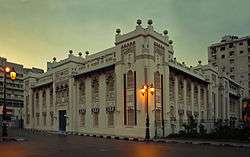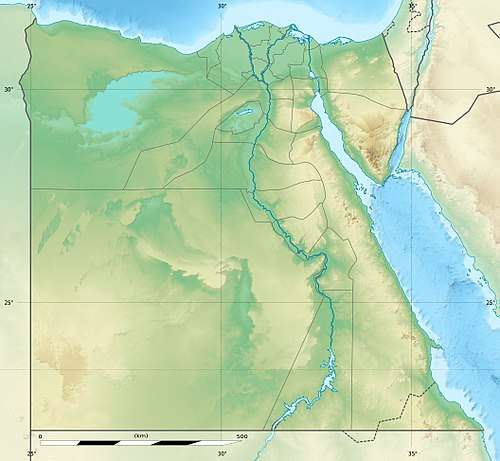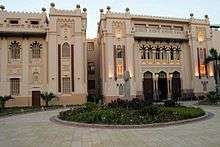Damanhur
Damanhur (Arabic: دمنهور Damanhūr, IPA: [dɑmɑnˈhuːɾ]; Egyptian: Dmỉ-n-Ḥr.w; Coptic: ⲡϯⲙⲓⲛ̀ϩⲱⲣ Ptīminhōr; pronounced [ptəmənhoːr]; Ancient Greek: Ἑρμοῦ πόλις μικρά Hermopolis Mikra) is a city in Lower Egypt, and the capital of the Beheira Governorate. It is located 160 km (99 mi) northwest of Cairo, and 70 km (43 mi) E.S.E. of Alexandria, in the middle of the western Nile Delta.
Damanhur دمنهور | |
|---|---|
      Clockwise from top: Damanhur Opera House, Nasser Mosque, Inside Opera House, Galal Qoraytem square, Damanhur at Night, Damanhur Opera House | |
 Damanhur Location within Egypt | |
| Coordinates: 31°02′26″N 30°28′12″E | |
| Country | |
| Governorate | Beheira |
| Elevation | 18 m (59 ft) |
| Population (2011) | |
| • Total | 242,700 |
| Time zone | UTC+2 (EET) |
| Area code(s) | (+20) 45 |
In ancient Egypt, the city was the capital of Lower Egypt's 7th Nome of A-ment. It stood on the banks of a canal which connected the lake Mareotis with the Canopic or most westerly arm of the Nile.[1] The city was dedicated to the Ancient Egyptian god Horus. In Greek and Roman times, it was called Hermopolis Mikra or Hermopolis Parva, which would also give it an association with Hermes, the Egyptian Thoth.[2] As Hermopolis, the city attracted the notice of numerous ancient geographers, including Stephanus of Byzantium s. v., Strabo (xvii. p. 802), Ptolemy (iv. 5. § 46), and the author of the Antonine Itinerary (p. 154). It is a Roman Catholic titular see.
In 1799, the city revolted against the French, who cruelly crushed the rebels, killing 1,500.
In 1986, the population of Damanhur was 188,939. The richly cultivated Beheira province gives rise to mainly agricultural industries which include cotton ginning, potato processing, and date picking. It also has a market for cotton and rice.
Ahmed H. Zewail, who won the Nobel Prize for Chemistry in 1999, was born in Damanhur in 1946.
Etymology

| Țemāi en Ḥeru[3] in hieroglyphs |
|---|
Damanhur was known in the ancient Egyptian language as The City of (the god) Horus[4], on the grounds that it was a center for the worship of this god. It was also known by other names: in the Egyptian texts, "Behdet"[5]; in the Greek texts "Hermou Polis Mikra" (the lesser city of Hermes), translated to Latin by the Romans as "Hermopolis Parva"; the name "Obollenoboles" (or Apollonopolis) associated it with the Greek god Apollo, and it was also called "Tel Ballamon". Now it is known by its oldest name, which was rendered in Bohairic Coptic: Ⲡⲓϯⲙⲓⲛ̀ϩⲱⲣ or Ⲡⲧⲓⲙⲉⲛϩⲱⲣ[6], and thus rendered in Arabic as "Damanhur" following the Islamic conquest.
Climate
Being located close to the Nile Delta and the northern coast of Egypt, that give Damanhur a hot desert climate (Köppen: BWh), moderated by blowing winds coming from the Mediterranean Sea, typical to the coast. The city gets average precipitation during winter, and rare rain during other seasons. Hail and frost are not unknown specifically during winter.
| Climate data for Damanhur, Egypt | |||||||||||||
|---|---|---|---|---|---|---|---|---|---|---|---|---|---|
| Month | Jan | Feb | Mar | Apr | May | Jun | Jul | Aug | Sep | Oct | Nov | Dec | Year |
| Average high °C (°F) | 18.3 (64.9) |
19.1 (66.4) |
21.7 (71.1) |
25.6 (78.1) |
29.4 (84.9) |
31.2 (88.2) |
32.0 (89.6) |
32.3 (90.1) |
30.8 (87.4) |
29.1 (84.4) |
24.8 (76.6) |
20.3 (68.5) |
26.2 (79.2) |
| Daily mean °C (°F) | 13.0 (55.4) |
13.6 (56.5) |
15.8 (60.4) |
19.0 (66.2) |
22.7 (72.9) |
25.0 (77.0) |
26.2 (79.2) |
26.4 (79.5) |
25.1 (77.2) |
23.2 (73.8) |
19.4 (66.9) |
15.0 (59.0) |
20.4 (68.7) |
| Average low °C (°F) | 7.8 (46.0) |
8.2 (46.8) |
9.9 (49.8) |
12.4 (54.3) |
16.0 (60.8) |
18.9 (66.0) |
20.5 (68.9) |
20.6 (69.1) |
19.4 (66.9) |
17.3 (63.1) |
14.0 (57.2) |
9.7 (49.5) |
14.6 (58.2) |
| Average precipitation mm (inches) | 25 (1.0) |
21 (0.8) |
9 (0.4) |
4 (0.2) |
3 (0.1) |
0 (0) |
0 (0) |
0 (0) |
0 (0) |
5 (0.2) |
13 (0.5) |
22 (0.9) |
102 (4.1) |
| Source: Climate-Data.org[7] | |||||||||||||
Tomb of Jakov Abuhassira (or simply Abo Hassira)
A nearby town called Damityo (3 kilometres (1.9 mi) south of Damanhur) contains the tomb of the Yaakov Abuhatzeira (1805–1880), a Moroccan rabbi who died there in 1880 while on a pilgrimage to the Holy Land. The site is visited each year by hundreds of devotees, with protests from local inhabitants.[8] A high court in Egypt officially removed the tomb from a list of sites of historical value, so Egyptian government protection stopped.[9] Some Egyptians have protested against permitting Jews to enter Egypt to make the annual pilgrimage to Rabbi Abuhatzeira's tomb.[10][11]
References
- Champollion, L'Egypte, vol. ii. p. 249
- . Encyclopædia Britannica. 7 (11th ed.). 1911. p. 783.
- Wallis Budge, E. A. (1920). An Egyptian hieroglyphic dictionary: with an index of English words, king list and geological list with indexes, list of hieroglyphic characters, coptic and semitic alphabets, etc. Vol II. John Murray. p. 1062.
- Peter, Clarke (2004). Encyclopedia of New Religious Movements. Routledge. p. 158. ISBN 9781134499700.
- Iskander, Zaky; Badawy, Alexander (1965). Brief History of Ancient Egypt. Madkour Press. p. 22.
- Gardiner, Alan (December 1, 1944). "Horus the Beḥdetite". The Journal of Egyptian Archaeology. 30 (1): 23–60. doi:10.1177/030751334403000104.
- "Climate: Damanhur - Climate graph, Temperature graph, Climate table". Climate-Data.org. Retrieved 13 August 2013.
- Barak, David. Mubarak to allow Jewish pilgrims to visit famous rabbi's tomb, Haaretz, (December 30, 2009).
- Lipton, Edward P. (2002). Religious Freedom in the Near East, Northern Africa and the Former Soviet States. New York: Nova Publishers. p. 18. ISBN 978-1-59033-390-7. Retrieved 2011-02-16.
- Miller, David E. (28 December 2010). "Israeli pilgrims to Egyptian grave met with hostility" (Reprint). The Media Line. Retrieved 2011-02-16.
- "Cairo Airport prepares for Israeli pilgrims". Al-Ahram. 26 December 2010. Retrieved 2011-02-16.

External links
- Falling Rain Genomics, Inc. "Geographical information on Damanhur, Egypt". Retrieved 2008-03-30.
- https://www.facebook.com/Egy.Dam Official Facebook page for the city
- https://web.archive.org/web/20051107230115/http://www.damanhour.5u.com/en.htm English script
- https://web.archive.org/web/20080321235728/http://www.saeednet.4t.com/ live cam from damanhour
- S. Pétridès (1913). . In Herbermann, Charles (ed.). Catholic Encyclopedia. New York: Robert Appleton Company.